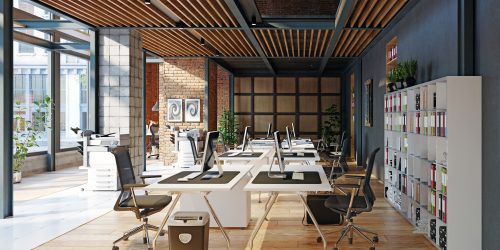5 tips for workspace optimisation designed for companies and remote working
A well-organised workspace promotes concentration, productivity, and employee well-being. Efficient office management improves your business’s operation and performance. So how do you go about planning your office and optimising your space? Discover some practical tips you can apply during on-site work and at home.
1. Think about the workplace layout
Before embarking on any refits, you should always think carefully about new uses of office space, so that you can steer the project in the right direction and allocate the appropriate budget.
The aim is to find a balance between separate and shared spaces, meeting, and relaxation areas. Teams always need places to focus, meet, and collaborate. There are several workplace layout options available to you:
- The open plan office;
- The flexible office, co-working or “flex office” where employees no longer have a fixed place;
- The private office.
The layout of offices therefore requires you to analyse staff flow, room occupation, circulation areas, and emergency exits.
If you’re working remotely, setting up an office space involves certain constraints such as lack of space or living with a family. Once you have decided which room you want for your office (living room, bedroom, guest bedroom, etc.), there are several “space-saving” options for fitting out this small space. For example, a remote working employee can turn a corner of his or her living room into an office area. They can also install a two-in-one item of office furniture, which returns to its original function outside of home working hours.
2. Opt for suitable furniture
Optimising offices is about creating stimulating workstations. The choice of aesthetic furniture promotes company identity, but the equipment must also be functional. Whether it’s a small office or an open-plan office, quality office furniture is ergonomic. In fact, adapting the furniture to your employees’ activity helps to prevent musculoskeletal disorders (MSD). For example, ergonomic office chairs relieve back problems and encourage good posture.
In addition, functional office furniture is modular. Installing adaptable furniture makes it easier for employees to move around the company and promotes teamwork. Height-adjustable desktops, folding tables, chairs with castors, and removable partitions are all practical tools for a flexible workspace.
But how do you combine professional equipment with CSR? By opting for eco-friendly office furniture and investing in custom-made, durable, and environmentally friendly furniture. In addition to choosing approved furniture, there are many suitable storage solutions for workspace optimisation.
3. Plan for storage space
Productivity can only be achieved with an organised workspace! This is especially true of small spaces where papers and supplies quickly pile up in corners. Whether you are working remotely or working in a company, here are some ideas for maintaining an orderly work environment:
- Install bookcases and/or shelves to keep useful documents close at hand;
- Schedule regular sorting sessions (once or twice a month) to avoid cluttering the space;
- Tidy up the room or workspace after each use;
- Favour virtual storage systems, where possible.
In an open space, you can also install individual storage units/lockers with secure access (code or padlock). Teams can store their work files and personal belongings there. In contrast to individual lockers, collective storage facilities (cupboards, bookcases or shelves) enable you to store documents for everyone’s use. At home, remote workers can opt for a desk with built-in storage or they can create some adjacent shelves.
Well-thought-out storage is essential for workspace optimisation and ensuring data security. However, order and cleanliness are not the only criteria for a comfortable office.
4. Find a good balance of brightness, temperature, and sound proofing
Office design and workspace optimisation are about creating a pleasant working environment.
The first step is to think about which way your office faces in order to make the most of natural light. Since the amount of sunlight in a room varies according to the season and the time of day, adding desk lamps ensures that the workspace is always bright.
Secondly, you must ensure that the thermostat is set to the correct temperature. Checking the office’s insulation will help you to avoid draughts while maintaining good ventilation.
Last but not least, noise pollution disturbs concentration and should be kept to a minimum. If you want to manage the noise that arises from employee activities, you can define three distinct zones.
- Noisy;
- Mixed;
- Silent.
As well as collaborative discussion spaces such as meeting rooms, it is important to provide quiet work areas. For example, isolation bubbles for telephone calls or soundproof panels reduce distractions in a given workspace.
5. Prevent psychosocial risks
Whatever the structure, any new changes you make must be accompanied by the appropriate support services to reassure teams and help them adapt well to these changes. Changes in the workspace can generate apprehension, stress, and even unease.
In fact, workspace optimisation has an impact on both the dissemination of the company culture and the integration of newcomers. For example, open-plan offices generally mean that employees are much more exposed to other people’s view, while remote working reduces interactions and can isolate staff.
It is therefore important to listen to the teams and consider their preferences. This is because your employees are going to be the end users of your optimised workspaces. It is therefore appropriate to involve them in making certain decisions by giving them opportunities to share their opinions or suggestions (choice of colours, decor options, customisation ideas, etc.).
You should also include relaxation areas and green spaces in the office to increase their well-being. Plants, flowers and shrubs are not just for decoration, but can also help usher a welcoming atmosphere in the company.
Office design and workspace optimisation: what should you do next?
Once your workspace is optimised, employees can move in. But the layout you have chosen probably won’t be definitive. The aim is to analyse your teams’ habits and get their feedback for potential improvements. Some changes may then be required to further optimise the workspace.
If you are short on ideas about how to design your office space, you can always contract a designer. After all, workspace optimisation will definitely make your company more attractive, and will foster employee development, which is a key element of well-being in the workplace.
Browse our range of office equipment here.





